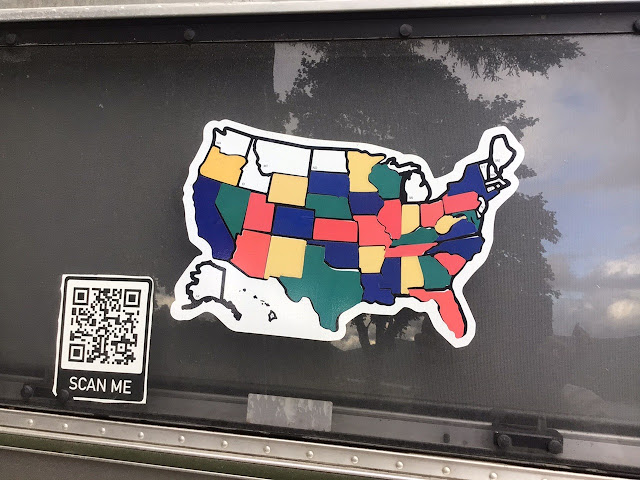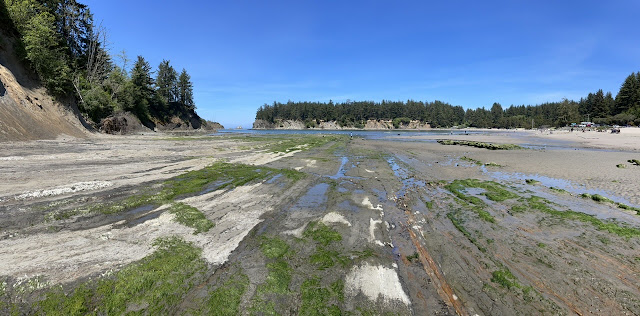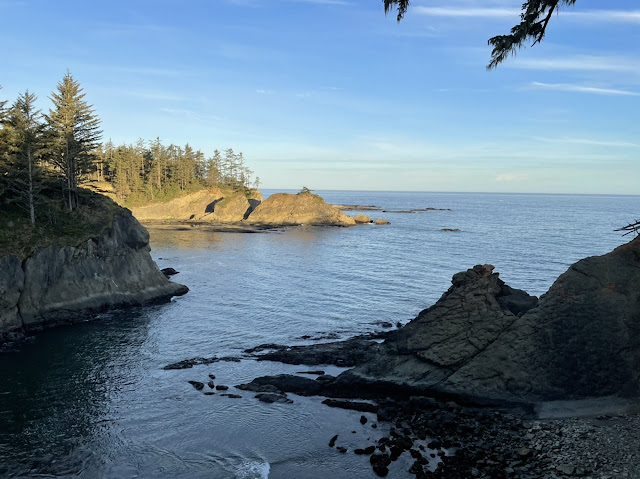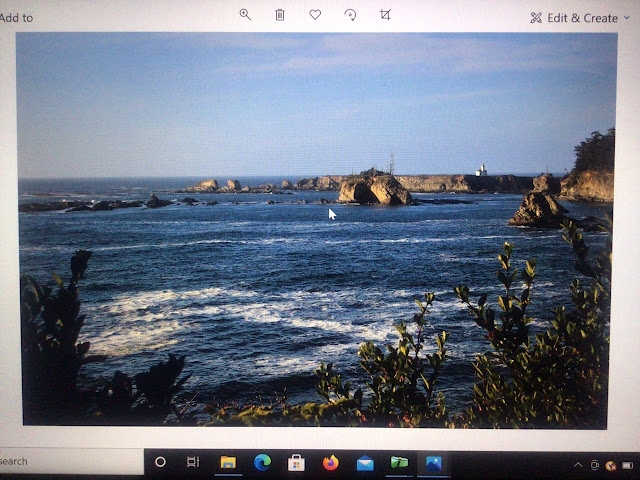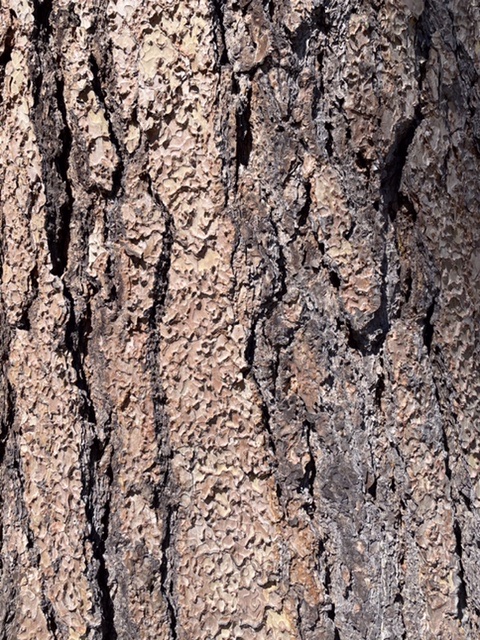Good afternoon, Campers, it’s Silver Cliche’ with you again from Fort Klamath, Oregon. Well, it’s official... we’ve “been to” Oregon. We are on full hookups here at the Crater Lake Resort. That means water, electric and, ah hum... waste water connections directly to the trailer. That elevates us from being “a tent with benefits” and we become “a tiny house on wheels”. That means long hot showers, laundry, thorough rinsing of dishes... the works! We can even run the water until it gets hot before soaping the dishes! I like Oregon!
Here’s the scorecard:
States visited this trip: 11. New states camped this trip: 3 (NV, CA, OR)
States camped lifetime: 35. New states to go this trip: 13 (WA, ID, MT, ND, MI, VT, NH, ME, RI, MA, CT, NJ, DE)
Before:
After:
I think I set off alarm bells last night by comparing the number of things here with the “Klamath” brand to the number in the East that the Trump Organization has slapped its brand on. There was concern that I might start an arms race that could have led to “Trump” on even more objects and products to catch up with Klamath-mania in Southern Oregon. I know some of you would have purchased that Trump bathroom tissue for all the wrong reasons. For you, fear not! “Klamath” is widely used here because it was the name of the group of indigenous people who were here when settlers arrived and began giving things the names they still carry. Rivers, towns, forests, businesses, and who knows what else memorialize the prior occupants of this land. I guess that’s a tribute... maybe? So far I haven’t met an actual Klamath person, though.
I didn’t get a chance to talk about the land much yesterday. Today was a down day for us. The weather was cool. The high temp measured at the Silver Cliche’ weather station was 64. It was mostly cloudy and we even saw a sprinkle. The National Weather Service told us that was coming and tomorrow us supposed to be better, so we plan to drive 30 minutes up the road to the National Park to see Crater Lake tomorrow. Since we were lazy today, let me catch you up on where we are.
After we passed Mt Shasta yesterday (I’m still thinking about how impressive a mountain that is) we eventually reached 5,000 feet above sea level near the California/Oregon border. We settled back to about 4,000 feet as we drove an hour into Oregon through a series of open, flat valley floors separated by minor hills. Agriculture was evident but not the “let’s feed the world” type we saw in California. Oregon agriculture looks more like “let’s feed Oregon”.
However, that’s not the case when it comes to wood. We saw 18 wheelers that looked overloaded with 4 logs. The areas that were not cleared for crops or grazing were covered with trees... mostly conifers. They were sparse in some areas and denser in others. Some areas had been clear cut and not yet regrown. Others had clearly burned leaving only charred trunks and branches with no evidence of life left in the trees.
The most impressive lumber operations we saw were near Klamath Falls. Both were sawmills located on bodies of water. The larger of the two, which was also closer to the road we were on, turned out to be Columbia Forest Products plywood mill. It was clear that timber arrives at this mill on the Klamath River. I don’t mean by boat. I mean there was a huge system of chains, nets, and whatever-it-takes to retrieve huge logs from the Klamath River itself. How they got into the river and where they floated from was not clear, but these logs were floating. I had visions of men with spiked boots and long poles dancing log to log to keep them moving. “We’ve got us a logjam!” Maybe that’s a relic from cartoons. Let’s hope so because this business is dangerous enough. When I looked to Google for a picture to share with you, half the stories about that mill described workplace fatalities. I worked for 35 years but never swiped my badge in the morning and thought “This could be the day a desk falls in me and ends it all.”. The people who do this work so we have walls, roofs, furniture and such clearly think those thoughts. Thank you! Please stay safe.

It’s clear that once the workers of Columbia snag the logs from the river that they stack them. Makes sense. Who wants soggy plywood? I was looking for words to describe the scale of the log pile outside Columbia. Football field? Nope. Aircraft carrier? Nope. NFL stadium? Maybe. Eventually I concluded the closest I could get would be New York City block 20 feet high stacked with logs. By logs, I mean entire trees, sans branches, where the bottom is 3-4 feet in diameter and the other end about 2 feet. It’s a lot of wood! And remember, wood is in demand right now. There is a nationwide shortage of lumber. That pile of wood isn’t a glut. Presumably it’s bigger if things are slow.
They say that eskimos have 45 words for “white”. (Actually, that was debunked decades ago but I needed to scrape the bottom of the barrel for this next bit.) I’m thinking that Oregonians have at least that many for “pine tree”. There are pines, but also larches, firs, redwoods, spruce and... well... 40 other things that aren’t palms or oaks or anything like that. It appears that they all grow here. I’m a bit sheepish to ask anyone about the “pine trees” to avoid exposing my ignorance. “Oh, do you mean the MacNab Cypress over there or that Western Red Cedar next to it?”. Deer... headlights... crickets... “Never mind. Do you have any DuraFlame logs? I need two boxes. Thanks.”
So after passing the plywood factory we drove by Klamath Falls, a city of 30-something thousand population. It looked good from the highway. We might stop by tomorrow for a little resupply. We drove along Upper Klamath Lake which is the largest lake “by surface area” in the state of Oregon. Evidently there is a larger lake “by volume of water” in some other part of the state and they were not ready to lose their title when Upper Klamath was formed by the damming of the Link River (yes... later renamed the Klamath River).
We are now camped at Crater Lake Resort on Fort Creek in Fort Klamath. Our campsite literally backs to the creek.
This is a nicely run little business. The grounds are clean and well done. They have amenities for all ages. It’s a bit pricey (seriously... like city prices) but it’s clear that they spend money to make it right. They have little cabins, “glamping” tents, canoes, etc.. The water in Fort Creek is about as crystal clear as any water I’ve ever seen in nature. Last night at dusk I could hear the elk bugling somewhere between here and the lake which is about a mile away. We were headed to a “first come first served” open parking area near the National Park for this stop but decided we needed a quiet place with more services to hunker down. This will do fine.



Tomorrow it’s Crater Lake and maybe Klamath Falls (did I mention there are not actually falls there?). I hope you’ll come with us!
Later...







